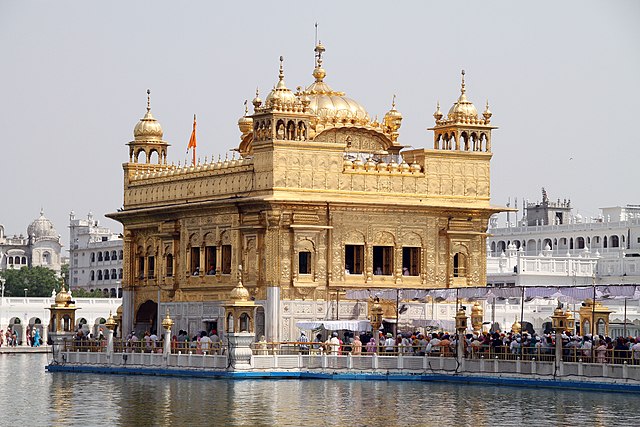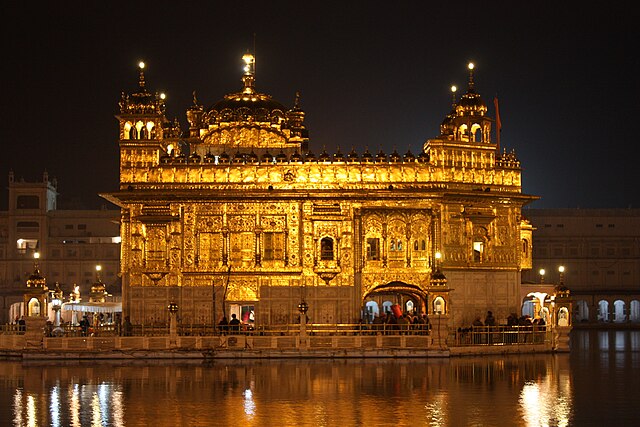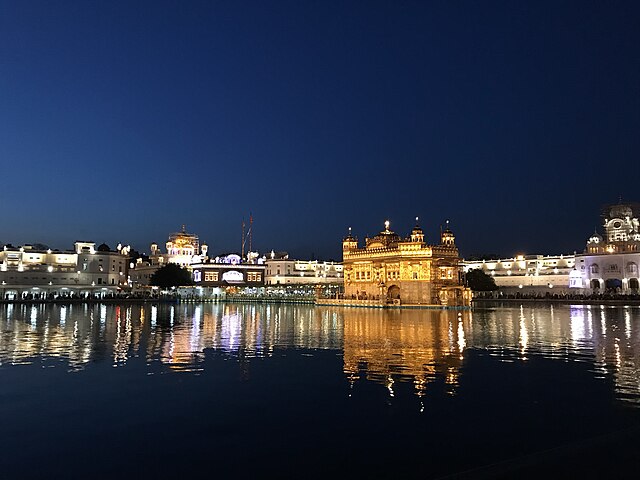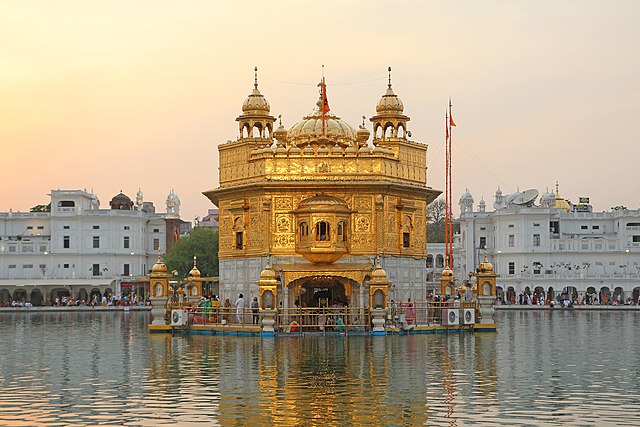Have you ever wondered what it feels like to step into a place where time seems to stand still, where golden reflections dance on sacred waters, and where thousands of people from all walks of life come together in perfect harmony? Welcome to the Golden Temple Amritsar, officially known as Harmandir Sahib – a spiritual oasis that’s not just the holiest shrine of Sikhism, but also one of India’s most magnificent architectural wonders.
What Makes the Golden Temple So Special?

Picture this: a gleaming golden structure floating serenely in the middle of a sacred pool, connected to the marble-clad perimeter by a causeway that seems to bridge the earthly and the divine. That’s your first glimpse of the Golden Temple, and trust me, it’s an image that’ll be etched in your memory forever.
A Brief Introduction to Harmandir Sahib
The Golden Temple isn’t just a building – it’s a living, breathing symbol of faith, equality, and human compassion. Located in the heart of Amritsar, Punjab, this sacred site attracts over 100,000 visitors daily, making it one of the most visited religious sites in the world. But what makes it truly special isn’t just its golden facade or architectural brilliance; it’s the spirit of inclusivity that welcomes everyone, regardless of their religion, caste, creed, or social status.
The name “Harmandir Sahib” literally translates to “Temple of God,” and that’s exactly what it represents – a divine space where the human soul can connect with the infinite. The golden plating that gives the temple its popular name was added much later in its history, but we’ll dive into that fascinating story shortly.
The Rich History Behind the Golden Temple
Every stone, every golden panel, every reflection in the sacred pool tells a story that spans over four centuries. The history of the Golden Temple is like a tapestry woven with threads of devotion, sacrifice, and unwavering faith.
Foundation by Guru Ram Das
The story begins in 1577 with Guru Ram Das, the fourth Sikh Guru, who founded the city of Amritsar around a sacred pool called Amrit Sarovar (Pool of Nectar). Legend has it that this pool possessed healing properties, and people would travel from far and wide to bathe in its holy waters. Guru Ram Das envisioned this place as a center of Sikh pilgrimage and spiritual learning.
But here’s what makes this foundation story even more remarkable – Guru Ram Das didn’t just establish a religious site; he created a planned city with the temple at its heart. The four roads leading to the temple complex symbolized the four directions, representing the Sikh belief that their faith was open to people from all corners of the world.
Construction Under Guru Arjan Dev
The actual construction of the temple began under Guru Arjan Dev, the fifth Sikh Guru, in 1588. What’s fascinating is that Guru Arjan Dev invited Mian Mir, a Muslim saint from Lahore, to lay the foundation stone. This gesture perfectly embodied the Sikh principle of religious harmony and mutual respect.
The construction took eight years to complete, and when it was finished in 1604, it was unlike any other religious structure of its time. While most temples were built on elevated platforms, the Golden Temple was constructed at a level lower than the surrounding land. This design choice wasn’t accidental – it symbolized humility and the idea that one must humble oneself to approach the divine.
Destruction and Reconstruction Through the Ages
The Golden Temple’s history isn’t just about peaceful construction and spiritual growth. Like many sacred sites in India, it faced numerous invasions and attacks throughout the centuries. Afghan invaders destroyed the temple multiple times in the 18th century, but each time, the Sikh community came together to rebuild their most sacred shrine.
The most significant reconstruction came under Maharaja Ranjit Singh in the early 19th century. It was during this period, in 1830, that the temple received its iconic golden covering. Maharaja Ranjit Singh ordered the upper floors of the temple to be covered with gold leaf, transforming it into the glittering marvel we see today.
Architectural Marvel: Understanding the Golden
Temple’s Design

If architecture is frozen music, then the Golden Temple is a symphony of spiritual harmony. Every element of its design carries deep symbolic meaning, creating a structure that’s not just beautiful to behold but also rich in spiritual significance.
The Sacred Pool (Amrit Sarovar)
The heart of the Golden Temple complex is the Amrit Sarovar, a rectangular pool measuring 150 feet by 150 feet. This isn’t just any water body – it’s considered sacred by Sikhs and is believed to have healing properties. The pool is fed by underground springs and is constantly cleaned and maintained by devotees.
What strikes most visitors is the perfect reflection of the golden temple in these waters. It’s like nature’s own mirror, doubling the beauty and creating a sense of infinite space. Early morning and evening are particularly magical times when the golden structure seems to float between sky and water, creating an almost ethereal atmosphere.
The marble steps leading into the pool are worn smooth by millions of feet over the centuries. Pilgrims take ritual baths here, believing that the sacred waters will cleanse them of their sins and cure ailments. Whether you believe in the mystical properties or not, there’s something undeniably peaceful about watching the gentle ripples disturb the golden reflection.
The Golden Structure and Its Significance
The temple itself is a three-story structure that rises from the center of the pool like a golden lotus emerging from water. The design beautifully blends Hindu, Islamic, and Sikh architectural elements, reflecting the inclusive philosophy of Sikhism.
The lower level houses the Guru Granth Sahib, the holy book of the Sikhs, during the day. The continuous recitation of hymns (kirtan) creates a spiritual atmosphere that envelops visitors in a cocoon of peace and devotion. The acoustics of the temple are designed so perfectly that the melodious recitations can be heard clearly throughout the complex.
Materials and Craftsmanship
The golden covering that gives the temple its name is made of pure gold leaf applied over copper sheets. This wasn’t just about creating visual splendor – gold was chosen for its properties of not tarnishing or corroding, symbolizing the eternal and incorruptible nature of divine truth.
The intricate inlay work, carved marble, and decorative elements showcase the finest craftsmanship of the era. Precious stones, intricate floral patterns, and calligraphy from Sikh scriptures adorn the walls and domes. Every surface tells a story, every pattern carries meaning, making the temple not just a place of worship but also a masterpiece of applied arts.
Spiritual Significance in Sikhism
To understand the Golden Temple’s importance, you need to grasp its role in Sikh spirituality. This isn’t just a beautiful building – it’s the epicenter of Sikh faith and the embodiment of the religion’s core principles.
The Four Doors: Symbol of Equality
One of the most powerful symbols of the Golden Temple is its four entrances, facing the four cardinal directions. This design element isn’t merely architectural – it’s a profound statement about the inclusive nature of Sikhism. These four doors welcome people from all four corners of the world, regardless of their background, beliefs, or social status.
Think about it – in a time when many religious places restricted entry based on caste or social hierarchy, the Golden Temple threw open its doors to everyone. This revolutionary approach to religious inclusivity was way ahead of its time and continues to inspire people today.
Daily Prayers and Gurbani
The Golden Temple operates on a strict schedule of prayers and rituals that have been followed for centuries. The day begins before dawn with the ceremonial opening of the Guru Granth Sahib and ends late at night with its ceremonial closure.
Throughout the day, the continuous recitation of Gurbani (Sikh hymns) creates a meditative atmosphere that transforms the entire complex into a living prayer. The ragis (musicians) who perform these hymns are highly skilled artists who dedicate their lives to this spiritual service. Their melodious renditions of sacred verses create an audio landscape that elevates the soul and calms the mind.
Visiting the Golden Temple: A Complete Guide

Planning a visit to the Golden Temple? You’re in for a treat, but a little preparation will help you make the most of this incredible experience.
Best Time to Visit
While the Golden Temple is open 24/7 throughout the year, timing can significantly impact your experience. The cooler months from October to March offer the most comfortable weather for exploration. However, each season has its own charm.
Winter mornings are particularly magical when mist rises from the warm sacred pool, creating an almost mystical atmosphere around the golden structure. Summer visits, while hot, offer the advantage of longer days and spectacular sunset views. Monsoon season brings its own beauty with rain-washed marble gleaming and the pool brimming with fresh water.
If you want to avoid crowds, early morning hours (4-7 AM) or late evening (after 8 PM) are ideal. The temple looks absolutely stunning when illuminated at night, with the golden structure reflecting beautifully in the floodlit pool.
Entry Requirements and Dress Code
The Golden Temple welcomes everyone, but visitors are expected to follow certain guidelines out of respect for the sacred space and Sikh traditions.
What to Wear and What to Avoid
Covering your head is mandatory for all visitors – men, women, and children alike. If you don’t have a scarf or head covering, free cloth pieces are available at the entrance. Many visitors purchase beautiful traditional Punjabi dupattas from nearby shops as souvenirs.
Modest clothing is expected – this means no shorts, short skirts, or sleeveless tops. Your arms and legs should be covered. Remove your shoes before entering the complex; free shoe storage facilities are available. Going barefoot on the marble floors is part of the spiritual experience, connecting you physically with this sacred ground.
Avoid wearing leather items like belts, purses, or accessories, as they’re not permitted inside. Tobacco and alcohol are strictly prohibited, and visitors should be in a sober state of mind.
Photography Guidelines
Photography is generally allowed in most areas of the complex, and you’ll want to capture the stunning architecture and spiritual atmosphere. However, be respectful when photographing people in prayer or during religious ceremonies. Flash photography might not be permitted in certain areas, especially near the Guru Granth Sahib.
The best photography spots include the parikrama (circumambulation path) for wide-angle shots of the temple, the bridge leading to the main structure, and various corners around the pool for different perspectives of the golden reflection.
The Langar Experience: Community Kitchen Like No Other
If the Golden Temple’s architecture is food for the eyes, then the langar is nourishment for both body and soul. This free community kitchen serves tens of thousands of meals daily, making it one of the largest free kitchens in the world.
How Langar Works
The concept of langar was introduced by Guru Nanak, the founder of Sikhism, as a way to promote equality and serve humanity. At the Golden Temple, this tradition has been elevated to an art form of service and organization.
The langar operates round the clock, serving simple vegetarian meals to anyone who visits, regardless of their religion, race, or economic status. The sight of people from all walks of life sitting together on the floor, sharing the same simple meal, is a powerful demonstration of human equality.
The menu typically includes dal (lentils), roti (flatbread), rice, vegetables, and kheer (sweet rice pudding). The food is prepared by volunteers using donations from devotees. What’s remarkable is the scale – on busy days, the langar can serve over 100,000 meals!
Volunteering Opportunities
One of the most rewarding experiences at the Golden Temple is participating in seva (voluntary service). Visitors can help in various ways – washing dishes, preparing vegetables, serving food, cleaning the complex, or helping with shoe storage.
Don’t worry if you’ve never done this before – volunteers will guide you. There’s something deeply fulfilling about contributing to this massive operation of service. It’s a hands-on way to experience the Sikh philosophy of selfless service and community cooperation.
Accommodation Options Near Golden Temple
Staying near the Golden Temple allows you to experience the spiritual rhythm of this sacred place, from early morning prayers to the peaceful night closure ceremony.
Free Stay at Gurdwara
The Golden Temple complex offers free accommodation to pilgrims and visitors. The dormitory-style rooms are basic but clean, and staying here gives you the authentic experience of being part of the temple community. You’ll wake up to the sound of morning prayers and fall asleep to evening hymns.
Advance booking isn’t required, but during peak seasons and festivals, availability might be limited. The accommodation includes basic amenities, and guests are expected to follow gurdwara rules and participate respectfully in the community environment.
Hotels and Guest Houses
If you prefer more privacy and comfort, Amritsar offers numerous accommodation options within walking distance of the Golden Temple. From budget guest houses to luxury hotels, there’s something for every preference and budget.
Many hotels offer views of the Golden Temple, allowing you to witness the changing moods of this magnificent structure throughout the day. Heritage hotels in converted havelis (traditional mansions) provide an authentic Punjabi experience with modern comforts.
Transportation to Golden Temple Amritsar
Getting to the Golden Temple is relatively straightforward, with Amritsar being well-connected by air, rail, and road to major Indian cities.
By Air, Train, and Road
Sri Guru Ram Dass Jee International Airport is about 11 kilometers from the Golden Temple, with regular flights from Delhi, Mumbai, and other major cities. The airport also has international connections, making it convenient for overseas visitors.
Amritsar Railway Station is just 2 kilometers from the Golden Temple, with excellent train connections to Delhi, Mumbai, Kolkata, and other major cities. The railway station itself is a beautiful heritage structure worth admiring.
By road, Amritsar is connected via well-maintained highways. The drive from Delhi takes about 6-7 hours, passing through scenic Punjab countryside. State-run and private buses provide comfortable options for budget travelers.
Local Transportation
Once in Amritsar, auto-rickshaws, cycle-rickshaws, and taxis are readily available. However, many visitors prefer walking to the Golden Temple from nearby accommodations, as the approach on foot allows you to soak in the atmosphere of the old city.
The narrow lanes leading to the temple are lined with shops selling religious items, traditional Punjabi clothing, and local delicacies. This walk becomes part of the pilgrimage experience, building anticipation for the spiritual encounter ahead.
Other Attractions in Amritsar

While the Golden Temple is undoubtedly the main attraction, Amritsar offers several other significant sites that complement your spiritual and cultural journey.
Jallianwala Bagh
Just a 5-minute walk from the Golden Temple lies Jallianwala Bagh, a memorial that marks one of the most tragic events in Indian history. This public garden was the site of the 1919 massacre where British troops fired on peaceful protesters, killing hundreds of innocent people.
The memorial preserves the original well into which many people jumped to escape bullets, and bullet marks are still visible on the walls. It’s a sobering reminder of India’s struggle for independence and adds historical context to your Amritsar visit.
Wagah Border Ceremony
About 30 kilometers from Amritsar, the Wagah Border between India and Pakistan hosts a daily flag-lowering ceremony that’s become a symbol of patriotic fervor. The synchronized drill by border guards from both countries, accompanied by enthusiastic crowds, creates an electrifying atmosphere.
The ceremony happens every evening before sunset and is a unique spectacle of nationalism, tradition, and cross-border rivalry expressed through ceremonial precision rather than conflict.
Cultural Events and Festivals
The Golden Temple comes alive during various Sikh festivals and cultural events, offering visitors a chance to witness traditions in their full glory.
Guru Nanak Jayanti
The birthday celebration of Guru Nanak, the founder of Sikhism, transforms the Golden Temple into a festival of lights, music, and devotion. The entire complex is decorated with thousands of lights, creating a magical atmosphere that attracts hundreds of thousands of devotees.
Processions, special prayers, and community feasts mark this celebration. The langar operates at an even larger scale, with special delicacies prepared for the occasion.
Baisakhi Celebrations
Baisakhi, marking the Sikh New Year and the formation of the Khalsa, is another major celebration at the Golden Temple. The festival combines religious significance with the joy of harvest season, creating a perfect blend of spirituality and cultural celebration.
Traditional Punjabi folk dances, music performances, and special religious ceremonies make Baisakhi an unforgettable experience for visitors fortunate enough to be present during this time.
Tips for First-Time Visitors
Visiting the Golden Temple for the first time can be overwhelming in the best possible way. Here are some practical tips to help you navigate this incredible experience:
Start your visit early in the morning to avoid crowds and witness the serene beauty of sunrise over the golden structure. Carry a water bottle and comfortable walking shoes (though you’ll remove them before entering the complex). Learn a few basic Punjabi phrases – locals appreciate the effort and it enhances your cultural connection.
Don’t rush your visit. The Golden Temple rewards those who take time to absorb its atmosphere, participate in the community activities, and simply sit by the pool in quiet contemplation. Join the langar experience, volunteer for seva, and interact respectfully with other pilgrims and devotees.
Respect the religious customs even if they’re unfamiliar to you. The Sikh community is incredibly welcoming to visitors who show genuine respect and interest in their traditions. Consider hiring a local guide who can explain the historical and spiritual significance of various elements within the complex.
Most importantly, come with an open heart and mind. The Golden Temple isn’t just a tourist destination – it’s a living center of faith that continues to inspire millions of people. Whether you’re seeking spiritual enlightenment, architectural appreciation, or cultural understanding, this magnificent shrine offers something profound to every visitor.
Conclusion
The Golden Temple Amritsar stands as more than just an architectural marvel or religious site – it’s a beacon of humanity’s highest ideals. In a world often divided by differences, this sacred space demonstrates the power of inclusivity, service, and spiritual devotion. From its gleaming golden walls reflected in sacred waters to the humble service of langar, every aspect of the Golden Temple teaches us about compassion, equality, and the unity of all human beings.
Whether you visit as a pilgrim seeking spiritual solace, a traveler exploring India’s cultural heritage, or simply someone curious about one of the world’s most beautiful religious sites, the Golden Temple will leave an indelible mark on your heart and mind. It’s a place where the divine seems tangible, where centuries of faith have created an atmosphere of peace that transcends religious boundaries, and where the simple act of sharing a meal reminds us of our common humanity.
The Golden Temple isn’t just a destination – it’s a transformation waiting to happen, a reminder that in our diverse world, there are still places where love, service, and acceptance reign supreme.
Frequently Asked Questions
Q1: Is the Golden Temple really made of gold?
The Golden Temple’s upper floors and dome are covered with pure gold leaf applied over copper sheets, installed during Maharaja Ranjit Singh’s reign in 1830. While not solid gold, the approximately 162 kilograms of gold used in the plating creates the stunning golden appearance that gives the temple its popular name.
Q2: Can people of all religions visit the Golden Temple?
Absolutely! The Golden Temple welcomes visitors of all religions, races, and backgrounds. This inclusivity is fundamental to Sikh philosophy, symbolized by the temple’s four entrances facing all directions. However, all visitors must follow the dress code and respect the sacred customs.
Q3: Is the langar really free for everyone?
Yes, the langar (community kitchen) serves free meals to everyone who visits, regardless of their background or economic status. This tradition, started by Guru Nanak, serves tens of thousands of people daily and is maintained entirely through donations and volunteer service.
Q4: What’s the best time of day to visit the Golden Temple?
Early morning (4-7 AM) and evening (after sunset) are ideal times for a peaceful visit with fewer crowds. The temple looks spectacular when illuminated at night, and morning visits offer the serene beauty of sunrise reflecting on the golden structure and sacred pool.
Q5: How long should I plan to spend at the Golden Temple?
A meaningful visit typically requires 3-4 hours minimum, allowing time to circumambulate the complex, sit in peaceful contemplation, participate in langar, and possibly volunteer for seva. Many visitors spend an entire day, while some stay overnight to experience the full spiritual rhythm of this sacred place.

